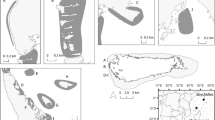Abstract
Prior research on manatee (Trichechus manatus latirostris) survival in northwest Florida, based on mark-resighting photo-identification data from 1982–1998, showed that annual adult apparent survival rate was significantly lower during years with extreme storms. Mechanisms that we proposed could have led to lower estimates included stranding, injury from debris, being fatally swept out to sea, or displacement into poorly monitored areas due to storm-generated longshore currents or storm-related loss of habitat. In 2004 and 2005, seven major hurricanes impacted areas of Florida encompassing three regional manatee subpopulations, enabling us to further examine some of these mechanisms. Data from a group of manatees tracked in southwest Florida with satellite transmitters during Hurricanes Charley, Katrina, and Wilma showed that these animals made no significant movement before and during storm passage. Mark-resighting data are being collected to determine if survival rates were lower with the 2004 and 2005 storms.
Similar content being viewed by others
Literature Cited
Beck, C. A. and J. P. Reid. 1995. An automated photoidentification catalog for studies of the life history of the Florida manatee, p. 120–134.In T. J. O'Shea, B. B. Ackerman, and H. F. Percival (eds.), Population biology of the Florida Manatee. U.S. Department of the Interior, National Biological Service Information and Technology Report I. Washington, D.C.
Bossart, G. D., D. G. Baden, R. Y. Ewing, B. Roberts, andS. D. Wright. 1998. Brevetoxicosis in manatees (Trichechus manatus latirostris) from the 1996 epizootic: Gross, histologic, and immunohistochemical features.Toxicologic Pathology 26: 276–282.
Brownie, C., J. E. Hines, J. D. Nichols, K. H. Pollock, andJ. B. Hestbeck. 1993. Capture-recapture studies for multiple strata including non-Markovian transition probabilities.Biometrics 49: 1173–1187.
Buergelt C. D., R. K. Bonde, C. A. Beck, andT. J. O'Shea. 1984. Pathologic findings in manatees in Florida.Journal of the American Veterinary Medical Association 185: 1331–1334.
Deutsch, C. J., J. P. Reid, R. K. Bonde, D. E. Easton, H. I. Kochman, andT. J. O'Shea. 2003. Seasonal movements, migratory behavior, and site fidelity of West Indian manatees along the Atlantic Coast of the United States.Wildlife Monographs 151: 1–77.
Hartman, D. S. 1979. Ecology and behavior of the manatee (Trichechus manatus) in Florida.American Society of Mammalogists Special Publication 5: 1–153.
Heinsohn, G. E. andA. V. Spain. 1974. Effects of a tropical cyclone on littoral and sub-littoral, biotic communities and on a population of dugongs (Dugong dugon (Müller).Biological Conservation 6: 143–152.
Landsea, C. W., N. Nicholls, W. M. Gray, andL. A. Avila. 1996. Downward trends in the frequency of intense Atlantic hurricanes during the past five decales.Geophysical Research Letters 23: 1697–1700.
Langtimm, C. A. andC. A. Beck. 2003. Lower survival probabilities for adult Florida manatees in years with intense coastal storms.Ecological Applications 13: 257–268.
Langtimm, C. A., T. J. O'Shea, R. Pradel, andC. A. Beck. 1998. Estimates of annual survival probabilities for adult Florida manatees (Trichechus manatus latirostris).Ecology 79: 981–997.
Lefebvre, L. W., M. Marmontel, J. P. Reid, G. B. Rathbun, andD. P. Domning. 2001. Status and biogeography of the West Indian manatee, p. 425–474.In C. A. Woods and F. E. Sergile (eds.) Biogeography of the West Indies. 2nd edition. CRC Press, Boca Raton, Florida.
Lott, N. 1993. The big one! A review of the March 12–14 1993 “Storm of the Century”. National Oceanic Atmospheric Administration National Climatic Data Center Publication TR 93-01. http://www1.ncdc.noaa.gov/pub/data/techrpts/tr9301/tr9301.pdf
Mangel, M. andC. Tier. 1994. Four facts every conservation biologist should know about persistence.Ecology 75: 607–614.
O'Shea, T. J., G. B. Rathbun, R. K. Bonde, C. D. Buergelt, andD. K. Odell. 1991. An epizootic of Florida manatees associated with a dinoflagellate bloom.Marine Mammal Science 7: 165–179.
Preen, A. R. andH. Marsh. 1995. Response of dugongs to largescale loss of seagrass from Hervey Bay, Queensland, Australia.Wildlife Research 22: 507–519.
Simpson, R. H. andH. Riehl. 1981. The Hurricane and Its Impact, Louisiana State University Press, Baton Rouge, Louisiana.
Stith, B., J. Reid, S. Butler, T. Doyle, and C. Langtimm 2004. Predicting the effects of hydrologic restoration on manatees along the southwest coast of Florida. U.S. Geological Survey. Fact Sheet 2004–3137. Gainesville, Florida.
U.S. Fish and Wildlife Service (USFWS). 2001. Florida Manatee Recovery Plan, 3rd revision, USFWS, Atlanta, Georgia.
Williams, B. K., J. D. Nichols, andM. J. Conroy. 2001. Analysis and Management of Animal Populations: Modeling, Estimation, and Decision Making. Academic Press, San Diego, California.
Author information
Authors and Affiliations
Corresponding author
Rights and permissions
About this article
Cite this article
Langtimm, C.A., Krohn, M.D., Reid, J.P. et al. Possible effects of the 2004 and 2005 hurricanes on manatee survival rates and movement. Estuaries and Coasts: J ERF 29, 1026–1032 (2006). https://doi.org/10.1007/BF02798665
Received:
Accepted:
Issue Date:
DOI: https://doi.org/10.1007/BF02798665




